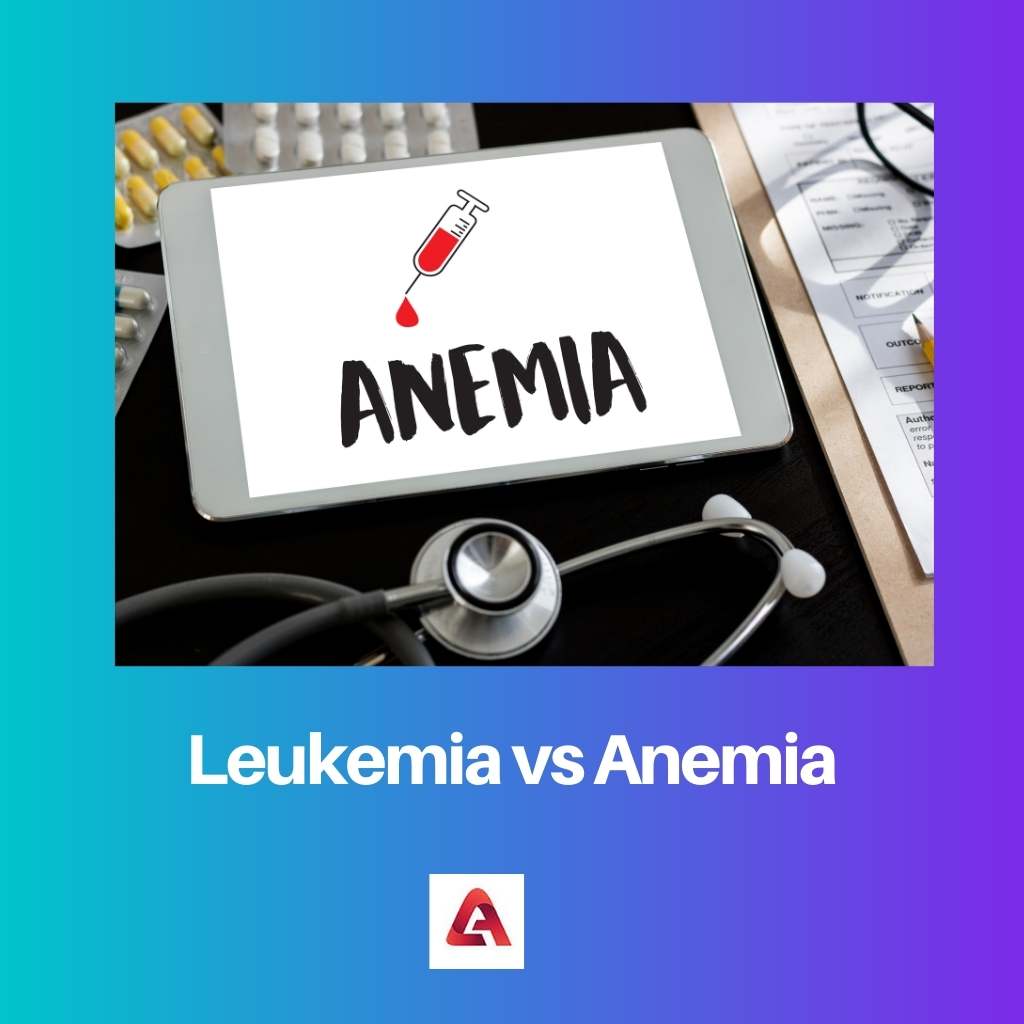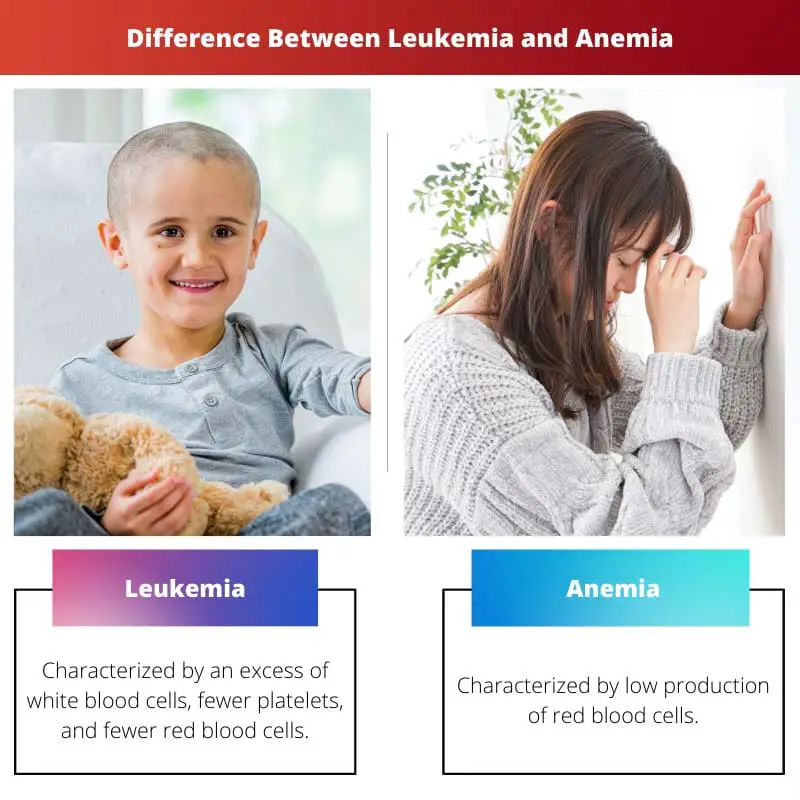Both anaemia and leukaemia are blood-related illnesses. Anaemia occurs when the blood’s haemoglobin level falls below the age and gender-appropriate reference standard.
Anaemia is characterized as having haemoglobin concentrations that are two standard deviations below the mean for your age or gender.
Anaemia is a sign of another disease, not a disease in itself. Leukaemia is a disease in which malignant stem cells proliferate in the bone marrow in clones.
When more than 25% of blast cells are detected in a bone marrow aspirate, it indicates the presence of leukaemia.
Key Takeaways
- Leukemia is a cancer of the blood-forming tissues, while anemia is a condition where the blood lacks sufficient healthy red blood cells.
- Genetic mutations and other factors cause leukemia, while anemia can result from various causes, such as iron, vitamin, and blood loss.
- Treatment for leukemia may involve chemotherapy, radiation, or stem cell transplantation, while anemia treatment depends on the underlying cause and may include supplementation or blood transfusions.
Leukaemia vs Anemia
Leukemia and anemia are both blood disorders. Leukemia is a type of cancer that affects the body’s ability to produce healthy white blood cells, while anemia is characterized by a lack of healthy red blood cells or hemoglobin.

Leukaemia is a malignancy that affects the blood and bone marrow and is caused by the excessive production of abnormal white blood cells.
The production of red blood cells and platelets inside the bone marrow is harmed by these aberrant white blood cells, which are unable to combat infection.
Acute and chronic leukaemia are two types of leukaemia.
Anaemia is a condition in which the body’s amount of healthy red blood cells is insufficient.
A low red blood cell count implies that the blood’s oxygen quantity is lower than it should be, as red blood cells supply oxygen to all of the body’s tissues.
Reduced oxygen transport to the body’s critical tissues and organs is the source of many of the symptoms of anaemia.
Comparison Table
| Parameters of Comparison | Leukemia | Anemia |
|---|---|---|
| Causes | Characterized by an excess of white blood cells, fewer platelets, and fewer red blood cells. | Characterized by low production of red blood cells. |
| Severity | Fatal cancerous disease. | Not a lethal condition. |
| Treatment | It is difficult to treat. | Readily cured. |
| Symptoms | No conclusive cause. | Blood loss, blood cell death, poor red blood cell synthesis, and fluid overload. |
| Diagnosing process | Diagnosed by bone marrow biopsy. | Diagnosed with a complete blood count (CBC) and a peripheral smear. |
What is Leukemia?
Leukaemia is a blood and bone marrow malignancy. Cancer is described as the uncontrolled proliferation of aberrant cells in simple terms.
Cancer can strike at any time and in any part of the body. This fast, out-of-control development of aberrant cells occurs in the bone marrow in leukaemia.
These aberrant cells subsequently leak into the circulatory system.
Leukaemia, unlike other malignancies, seldom forms a tumour that can be detected on imaging tests like X-rays.
Leukaemia comes in a variety of forms. Some are more prevalent among youngsters, while others are more prevalent among adults. The kind of leukaemia and other variables determines treatment.
Leukaemia is divided into two types based on how quickly the disease develops.
Acute leukaemia and Chronic leukaemia are the two types of leukaemia. Leukaemia cells divide swiftly, and the disease advances quickly. A person with acute leukaemia will get ill within weeks of the leukaemia cells developing.
The most frequent malignancy in children is acute leukaemia. In chronic leukaemia, the cells frequently have characteristics of both immature and adult cells.
Some of these cells may have progressed to the point where they operate as the cells they were designed to be, but not to the same degree as their regular counterparts.
When opposed to acute leukaemia, the disease progresses slowly. It’s possible that an individual may not notice any symptoms for years if they have chronic leukaemia.
Adults are more likely than children to develop chronic leukaemia.

What is Anemia?
Anaemia is defined as a lack of red blood cells or haemoglobin in the blood. Anaemia is a condition in which there aren’t enough healthy red blood cells in circulation.
The most frequent type of anaemia is rather harmless. On the other hand, Anaemia can sometimes be the first sign of cancer or another serious illness.
Anaemia is a common adverse effect of life-saving anti-cancer medication in other circumstances.
Anaemia caused by cancer therapy is a tremendous load that can lead to excessive exhaustion. There are several types of anaemia, each with its unique set of causes.
Anaemia can be either transient or chronic, and it can range from moderate to severe. A combination of factors causes anaemia.
Dietary iron, vitamin B-12, and folate are required for red blood cell maturation in the body.
Every day, 0.8 to 1% of the body’s red blood cells are replaced, and red blood cells have an average lifespan of 100 to 120 days.
Anemia can be caused by any mechanism that disrupts the equilibrium of red blood cell production and destruction. Anaemia diagnosis can vary based on the kind and root cause.
It entails collecting a blood sample and testing for haemoglobin, a protein found in the blood. Patients with leukaemia are prone to develop anaemia along with the root disease.

Main Differences Between Leukemia and Anemia
- Anaemia is a condition characterized by low production of red blood cells, whereas leukaemia is a malignancy and destruction of the bone marrow characterized by an excess of white blood cells, fewer platelets, and fewer red blood cells.
- Anaemia is not a lethal condition, but leukaemia is since it is a blood malignancy.
- Anaemia is readily cured, however, leukaemia is difficult to treat.
- Blood loss is the most prevalent sign of anaemia, although additional reasons include red blood cell death, poor red blood cell synthesis, and fluid overload. There is no conclusive cause of leukaemia.
- Anaemia is diagnosed with a complete blood count (CBC) and a peripheral smear, whereas a bone marrow biopsy is used to diagnose leukaemia.


I appreciate the detailed explanation of leukemia and anemia. It’s refreshing to see this in such a scientific manner.
This article provides a fascinating insight into the world of hematology. The readers can gain a profound understanding of the key differences between anemia and leukemia from this comprehensive source.
The article is very well-written and thorough. I appreciate the direct comparison between the two conditions, making it easier to understand the complexities of anemia and leukemia.
This is a very well-researched article that provides essential information about leukemia and anemia. The comparison table comes in handy to understand the differences.
This is a very interesting article. The comparison table simplifies the understanding of the two conditions.
It’s good to learn more about the differences between leukemia and anemia. This article provides a well-structured comparison.
The content in this article is presented in a comprehensive manner, and it certainly adds to existing knowledge about blood-related diseases.
Undoubtedly, the author has shed light on complex topics in a very readable way.
This is very informative. These details are crucial to understanding these blood disorders.
The article provides a very detailed and informative comparison between leukemia and anemia. I particularly appreciate the section explaining the diagnosis process for both conditions.
I found this article extremely educational, it’s a valuable source of information for anyone interested in understanding the differences between these two conditions.
I agree, the diagnostic process section is very comprehensive. The information in this article is very reliable and well-explained.
The author uses clear and scientific language to explain the differences between anemia and leukemia. This makes it an authoritative source for those seeking detailed medical information.
I don’t think the article is entirely accurate. It oversimplifies the severity of anemia by stating that it is readily cured. The causes and treatments of both diseases are much more nuanced.
Well, I thought I understood these two conditions, but I’ve learned a lot from this. Great job!
Absolutely agree. The detailed information provided is definitely enriching.
The key takeaways make it easier to grasp the differences. A very valuable read indeed.